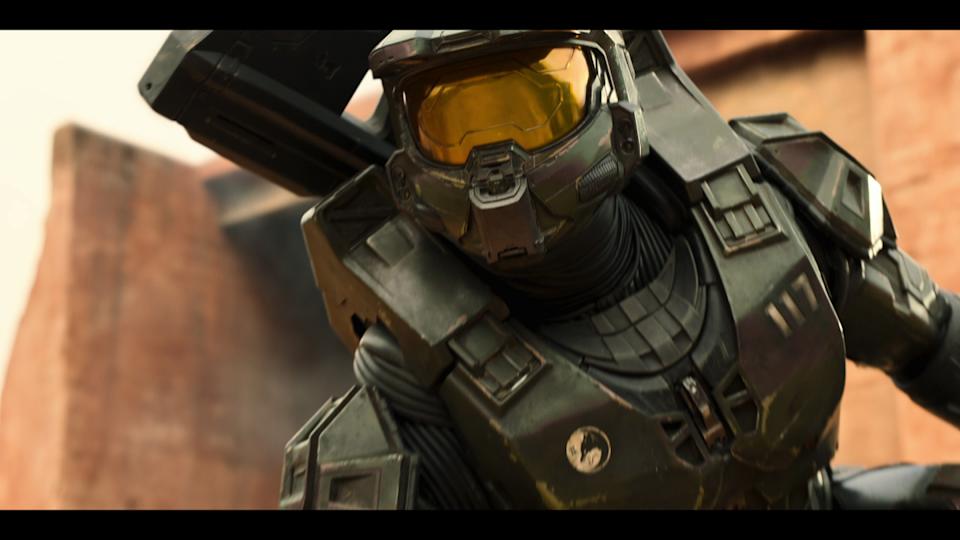It’s a moment 20 years in the making: In the closing moments of the Halo series premiere, fans of the blockbuster video game franchise finally get a chance to peek beneath the helmet of heavily-armed hero, Master Chief. And star Pablo Schreiber — who plays the avatar so many gamers have controlled since the first Halo launched on Xbox in 2001 — felt the weight of both the scene … and the helmet.
“Shooting that scene was so loaded,” the actor tells Yahoo Entertainment now. “There was a lot of tension — good tension! — on set. All the keepers of the Halo franchise were there, and it was emotional for many of them.”
Kiki Wolfkill was among the Halo overlords who experienced all the feels when Master Chief’s face was revealed for the first time in the franchise’s two-decade history. “People have been waiting 20 years for this,” emphasizes the veteran video game developer, whose personal Halo history dates back to 2008 when she oversaw Halo 4. “I spent a lot of time explaining just how much it was really going to mean to people. We had to make sure it really had gravitas and purpose.”
[embedded content]
Let’s quickly hit the “Pause” button and revisit the past campaigns to bring the world of Halo to life onscreen. After the original game became a console-launching smash, Hollywood quickly swooped in with dreams of turning it into the next big action movie franchise. Fresh off his triumphant Lord of the Rings trilogy, Peter Jackson attached himself to the nascent project in 2005, and hand-picked Neill Blomkamp to direct. But then those dreaded “creative differences” reared their ugly heads, and Master Chief landed in development hell as both the gamemakers and filmmakers tried to reconcile their visions for what a Halo movie could be.
By the time that Wolfkill joined the franchise in 2008, it was already beginning to look like the best version of Halo would be a TV series rather than a feature film. The launch of Halo 4 — which featured a more dramatic arc for Master Chief — four years later confirmed her feelings that the solution to the previous adaptation problems lay in long-form storytelling. “We wanted to tell his story and have the time to do it,” she says. “What we learned looking at our previous experiences was: ‘We’re not in a hurry.'”
Halo was officially reborn as a small-screen experience in 2013 when Steven Spielberg replaced Jackson as the project’s new A-list executive producer. But even then, it didn’t exactly rush into production. The development wheels kept on grinding for five years, until Showtime finally stepped up and hit “Start.” (In 2021, Showtime’s corporate owners at Viacom moved the series to its recently-launched Paramount+ streaming platform.)
Wolfkill says that Halo‘s current incarnation retains next to nothing from the abandoned versions. “It’s a ground-up reinvention not for any other reason than the focus is on telling this story. Once you have that, all the other pieces come into it. If you start from a place where you’re pulling from other things, you’re already starting to put restrictions on the story and we needed that to be the thing that everything really grew from.”
Which brings us back to Schreiber’s story of taking off Master Chief’s helmet on camera for the first time. The plot of the Halo series follows the super-soldier — who also goes by John-117 — as he goes on a quest to discover the truth about his own origins: a mission that puts him at odds with his own masters at United Nations Space Command. Exposing his face is his first step towards discovering the identity behind his military rank.
“In the evolution of John, it’s your absolute first exposure to the man,” notes Schreiber, who won the role in 2019 when Rise of the Planet of the Apes director, Rupert Wyatt, was behind the camera on the pilot. (Wyatt ultimately departed the series for scheduling reasons and BAFTA-winning Peaky Blinders helmer, Otto Bathurst, took over the director’s chair.) “It was a matter of establishing that strange mix of being drawn into something that you don’t quite understand, but being compelled to the point where you just feel like you can’t turn back.”
Asked whether he practiced John’s expression in a mirror prior to shooting that scene, Schreiber laughs and says it was just a matter of being as “present” as possible in the moment. “It’s a big moment for the franchise, and it comes with a lot of history and feeling. Throughout the first season, we explore the tension between Master Chief the soldier and John the human being. You have to get that moment to get to the others.”
Wolfkill adds that the helmet moment went through numerous revisions as the creative team tried to find the right motivation. “We came up with a lot of funny scenarios for it,” she remembers. “I couldn’t get the prop department to make a bunch of helmets so he could just take one off to find another one underneath — as we’ve seen on the internet! Long before we went into pre-production, we also had this idea that John putting the helmet on would help you realize that’s him, but once we developed the story that didn’t make sense. There were many ill-advised ideas!”
After traveling the long and winding road to making the first season of Halo a reality, Paramount+ wasted little time ensuring there’d be a Season 2. The sophomore year will go into production later this year with a new showrunner in charge — David Wiener is taking over from Steven Kane. “David’s an incredible writer,” Schreiber raves. “He’s going to bring a level of death and intelligence to the writers’ room that will take us to so many amazing places. The first season was a very good intro to John, but subsequent seasons will have the opportunity to deepen the story and talk about some of the larger themes that I’m really thrilled about.”
Halo‘s 20-year development process did mean that the franchise skipped over the era when video game-based movies and shows routinely flopped with critics and audiences — think 2005’s Doom, 2007’s Hitman and 2010’s Prince of Persia: The Sands of Time. Flash-forward to the 2020s, and Sonic the Hedgehog and Uncharted are running up box-office grosses, while The Witcher is one of Netflix’s biggest streaming hits.
“I think some of is just respect for the medium,” Wolfkill says of how Hollywood may finally have cracked the cheat code to getting video game adaptations right. “For those of us who have been in video games for a long time, we’ve always felt like there was a little bit of an underestimation of the depth and breath of these worlds that we’ve built, and the level of investment that fans have in them. In previous efforts, it’s been looked at like, ‘Oh, this game is fun — we’ll just copy it onto the screen.'”
“Nowadays, there’s just more care being taken around what it means to adapt and optimize for the medium you’re going into,” she continues. “I see how hard the cast and the crew and everybody worked to bring this show to life for fans, and I hope that’s something that people can see and embrace, even if they don’t agree with every decision we made.”
Halo premieres Mar. 24 on Paramount+




